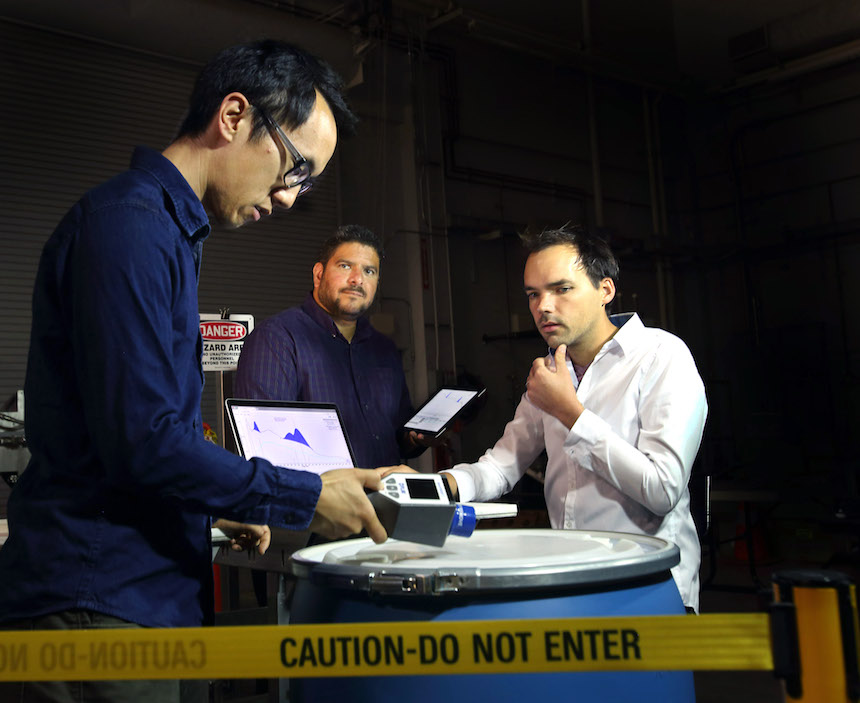
When law enforcement officers and first responders arrive at an emergency involving radiation, they need a way to swiftly assess the situation to keep the public and environment safe. Having analysis tools that can quickly and reliably make sense of radiation data is of the essence.
Decision-makers in these emergencies can now turn to a new Sandia National Laboratories-developed tool called InterSpec. A software application available for both mobile and traditional computing devices, InterSpec can rapidly and accurately analyze gamma radiation data collected at the scene.
Comprehensive, easy-to-use radiation analysis tool
Software developer and physicist Will Johnson said InterSpec updates, strengthens and integrates many radiation analysis tools and resources into a single mobile or desktop application that is seamless and intuitive to use.
“InterSpec allows decision-makers to rapidly identify both radioisotopes and shielding materials around the source,” Johnson said. “InterSpec is also a valuable tool for laboratories and other academic and industrial settings where an accurate understanding of detected radiological material is crucial.”
For the past four years, Sandia researchers have been making InterSpec easy to use in any situation by anyone who works with radioactive material. The Sandia team consists of Johnson and researchers Ethan Chan, Edward Walsh and Noel Nachtigal.
Sandia Lab says that InterSpec was created for people who have some radiation knowledge but are not experts. In many situations, radiation experts are not immediately available to assist law enforcement personnel and emergency responders. Using InterSpec, even people with limited analysis experience can obtain the detailed radiation information they need to make quick decisions.
“You can take the radiation data from any detector, and InterSpec will identify the radiation source, describe its shielding and calculate the radiation dose,” Walsh said. “InterSpec will also tell you if it’s dangerous for you to be around this source. The tool is amazing.”
Multiplatform tool with more features, larger database
InterSpec provides quick, useful radiation analysis by combining radiation physics, radiation transport calculations and detector response functions with a radioisotope database that is much larger than those found in similar products. These attributes enable InterSpec to rapidly compute radiation quantities, reducing user errors.
Sandia notes that unlike radiation-analysis software packages that are limited to Windows systems, InterSpec runs on multiple platforms, including Windows, Mac OSX, Linux, iOS, and Android, and on all web browsers.
The wide range of platforms means users in different settings can quickly exchange data and share a unified view of the data. Furthermore, InterSpec works in isolated or shielded environments with no network connectivity needed.
“We’ve made InterSpec as easy as possible to use,” Chan said. “You don’t have to spend two or three years to learn the tool. InterSpec is really simple, both in how it looks and how you use it.”
InterSpec features include work tracking, the ability to view and edit metadata and automatic saving of spectrum files. The spectrum files include location-embedded metadata for visualization on a map, so users can select a geographical region of measurements.
First-time users can access InterSpec’s help system and tool tips that describe each button’s function. In addition, intuitive icons enable users to move around the app quickly.
Using InterSpec in the field
Johnson serves on a Department of Energy team that identifies types of radiation found throughout the country.
“The goal of the team is to figure out if detected radiation is a threat or not,” he explained. “InterSpec helps determine if an item is a potential threat, and if so, what kind.”
Johnson said InterSpec has helped the team respond to events in the field. “The ability to analyze data before reaching a traditional computer or in situations where only a phone or tablet could be taken has proven extremely useful.”
InterSpec can be used to help determine the source nuclide type, strength and shielding inside sealed boxes or cargo containers.
“The Sandia team is working to make InterSpec available to people who conduct radiation measurement analysis so they can benefit from the improved workflows, capabilities and time savings of InterSpec,” Sandia Lab says.
This article published courtesy of Homeland Security News Wire

